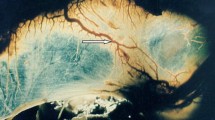Abstract
An incidental persistent falcine sinus was detected in an otherwise normal brain on MRI in a 12-year-old girl who underwent imaging after clinical suspicion of acute disseminated encephalomyelitis. The falcine sinus was associated with a hypoplastic posterior third of the superior sagittal sinus and a dominant straight sinus. Generally, atresia or hypoplasia of the straight sinus is associated with a persistent falcine sinus in postnatal life; otherwise, the falcine sinus disappears before birth. We discuss the embryological basis for such an association in this case.


Similar content being viewed by others
References
Strub WM, Leach JL, Tomsick TA (2005) Persistent falcine sinus in an adult: demonstration by MR venography. AJNR 26:750–751
Raybaud CA, Strother CM, Hald JK (1989) Aneurysms of the vein of Galen: embryonic considerations and anatomic features related to the pathogenesis of malformation. Neuroradiology 31:109–128
Huang YP, Okudera T, Ohta T (1984) Anatomic variations of the dural venous sinuses. In: Knapp JP, Schmidek HH (eds) The cerebral venous system and its disorders. Grune and Stratton, Orlando, pp 109–167
Streeter GL (1915) The development of the venous sinuses of the dura mater in the human embryo. Am J Anat 18:145–178
Kesava PP (1996) Recanalization of the falcine sinus after venous sinus thrombosis. AJNR 17:1646–1648
Sener RN (2000) Association of persistent falcine sinus with different clinicoradiologic conditions: MR imaging and MR angiography. Comput Med Imaging Graph 24:343–348
Bartels RH, Merx JL, Overbeeke JJ (1998) Falcine sinus and occipital encephalocele: a magnetic resonance venography study. J Neurosurg 89:738–741
Rollins N, Ison C, Reyes T, et al (2005) Cerebral MR venography in children: comparison of 2-D time-of-flight and gadolinium-enhanced 3-D gradient-echo techniques. Radiology 235:1011–1017
Reddy AT, Hedlund GL, Percy AK (2000) Enlarged parietal foramina: association with cerebral venous and cortical anomalies. Neurology 14(54):1175–1178
Author information
Authors and Affiliations
Corresponding author
Rights and permissions
About this article
Cite this article
Manoj, K.S., Krishnamoorthy, T., Thomas, B. et al. An incidental persistent falcine sinus with dominant straight sinus and hypoplastic distal superior sagittal sinus. Pediatr Radiol 36, 65–67 (2006). https://doi.org/10.1007/s00247-005-0009-x
Received:
Revised:
Accepted:
Published:
Issue Date:
DOI: https://doi.org/10.1007/s00247-005-0009-x




